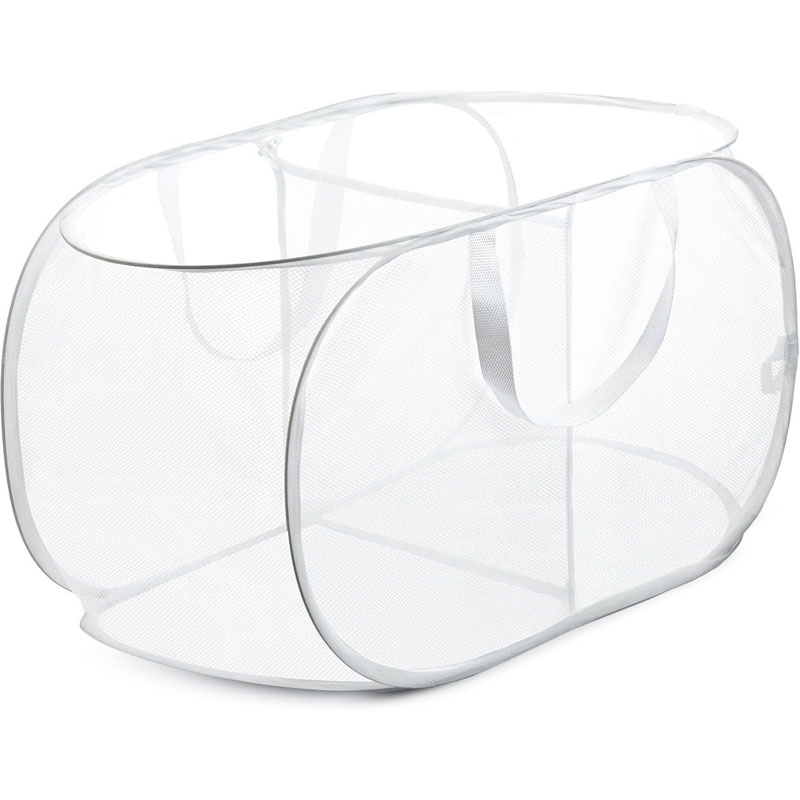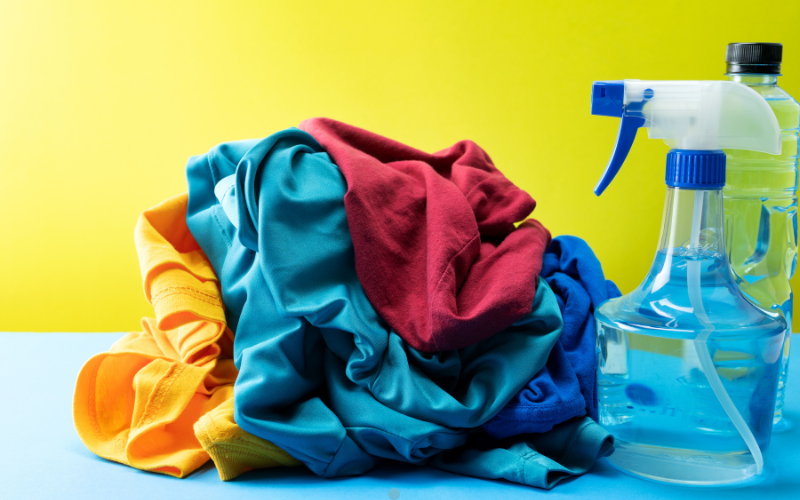How to Sort Laundry by Color?
Nov 25, 2024

When sorting laundry by color, it’s essential to prevent color transfer and preserve garment quality. Start by checking clothing labels for specific care instructions. Separate your white, light, dark, and bright colors into distinct piles. Whites should be washed in hot water to remove stains, while light colors need cold water to retain brightness. Dark colors like blacks and navies require separate washing to avoid dye transfer. Bright colors also need special handling to maintain their vibrancy. But what about those delicate fabrics and stubborn stains? Let’s explore the specifics of each category to keep your clothes looking their best.
Keep laundry day simple with our easy-to-use Pop-Up Laundry Basket – Shop now for hassle-free convenience!

Check Clothing Labels
Before you start sorting your laundry by color, always check the clothing labels for specific care instructions. These labels provide vital details about washing temperature, cycle type, and whether an item should be washed separately or with like colors. Paying attention to the care label can prevent dye bleed and maintain the quality of your clothes.
- When examining the care label, look for instructions that specify color and fabric type. These details are essential because different fabrics and colors may require unique washing conditions. For instance, bright or dark colors often need to be washed in cold water to prevent the colors from bleeding. The care label also indicates if an item should be cleaned with similar colors to avoid unwanted color transfer.
- Following these instructions helps maintain the appearance of your garments and extends their lifespan. Ignoring the care labels could result in faded colors, fabric damage, or even ruining other clothes in the wash. So, take a few moments to read the care label carefully before sorting your laundry. It’s a small step that makes a big difference in preserving your wardrobe.
Separate Whites

To keep your whites bright and free from color transfer, always wash them separately from dark or brightly colored items. This will prevent dyes from darker fabrics from bleeding onto your whites, keeping them looking crisp and clean.
- When you separate whites, gather all your white clothing items, such as socks, undershirts, and linens, into a separate pile.
- Washing whites in hot water is particularly effective. Hot water helps remove stains and germs, ensuring your white clothes aren’t only clean and hygienic. Consider using a bleach alternative or laundry booster if you’re dealing with stubborn stains. These products can boost your whites, making them look as good as new.
- Avoid throwing a stray item in with your white load, as even one brightly colored sock can ruin an entire batch of laundry. By diligently separating whites from colored items and using hot water, you’ll maintain the brightness and cleanliness of your white garments.
- This simple step can make a significant difference in the longevity and appearance of your clothing.
Sort Light Colors

Grouping light colors is crucial for maintaining brightness and preventing unwanted color transfer. When you sort light colors, it’s important to recognize that these include whites, pastels, and other pale shades. Keeping these items separate from darker clothing prevents them from picking up stray dyes that can dull their appearance.
- To start, gather all your light-colored clothes in one pile. This will make identifying any potential items that could cause issues if mixed with other shades easier. Washing light colors together keeps your laundry looking fresh and helps maintain the fabric's integrity.
- Always use cold water when washing light colors. Cold water settings are less harsh on the fabric and help preserve the brightness and vibrancy of your light-colored garments.
- Additionally, avoid mixing light colors with any dark or bright colors. Doing so can prevent unwanted staining and ensure your clothes look as good as new.
Read More: How to Choose a Laundry Basket?
Divide Dark Colors

Don’t mix blacks and navies when sorting dark colors to keep them vibrant and distinct. Group dark reds together, as their dye can bleed more readily. This simple step will help maintain the quality of your dark clothing.
Separate Black and Navy
Separating black and navy clothing from other dark colors is crucial to prevent dye bleeding and maintain color vibrancy. When you separate items like black and navy from your laundry, you prevent dye from these darker colors from transferring to other garments. This step guarantees your clothes retain their original richness and color intensity.
- First, place all your black and navy clothing in a distinct pile. These darker colors, especially during initial washes, release excess dye. Washing them together helps prevent this excess dye from dulling other dark clothes over time. It’s a simple step that makes a significant difference in the longevity and appearance of your wardrobe.
- Next, check for any care labels or special instructions on your garments. Some items might require cold water washes or specific detergents to maintain color. By taking these precautions, you’ll help keep the vibrancy of your black and navy clothes, ensuring they look as good as new for longer.
Group Dark Reds
Why should you separate dark reds from other dark colors in your laundry routine? Dark reds are notorious for bleeding, which can lead to color transfer onto lighter clothing. By grouping dark reds, you help maintain the vibrancy of the color and prevent them from fading or discoloring. This extra step in your laundry routine guarantees that your dark reds receive the proper care they need during washing.
Here’s a quick reference table to help you sort your dark reds effectively:
| Item Type | Reason to Separate | Care Tips |
| Dark Red Shirts | Prevent color bleeding | Wash in cold water |
| Dark Red Pants | Avoid color transfer | Use color-safe detergent |
| Dark Red Towels | Maintain vibrancy | Wash with similar colors |
| Dark Red Socks | Reduce fading | Turn inside out before washing |
Separating your dark reds from other dark colors minimizes the risk of color transfer, ensuring your laundry remains unblemished. Additionally, it helps keep the rich hue of dark reds intact, reducing the need for frequent replacement. Use cold water and a color-safe detergent to protect your dark reds from fading. You can extend the life and look of your favorite garments by giving special attention to your dark reds.
Handle Bright Colors
When handling bright colors, you should always separate them from dark items to prevent any color transfer. Using cold water for washing helps maintain the vibrancy of these garments and reduces the risk of dye bleeding. This simple step guarantees your bright clothes stay fresh and colorful for much longer.
Separate Bright From Dark
To keep your bright clothes looking their best, always wash them separately from dark colors to prevent color bleeding. Handling bright colors separately helps maintain their vibrancy and guarantees they don’t transfer their hues onto darker garments. By sorting your laundry this way, you safeguard your bright clothes from fading and keep them looking fresh and new for longer.
Here’s how to effectively separate your bright colors from dark colors:
- Sort Before Washing: Before you throw your clothes in the washer, take a moment to sort them. Separate bright reds, yellows, oranges from dark blues, blacks, and browns. This practice helps prevent color bleeding and prolongs the life of your clothes.
- Check Labels: Look at the care labels on your garments. Some bright colors may have specific washing instructions that suggest cold water or delicate cycles, which are crucial for maintaining their vibrancy.
- Group Like Colors: When handling bright colors, group similar hues together. For instance, wash all bright reds in one load and bright yellows in another. This prevents color transfer between shades, ensuring each garment retains its original brilliance.
Use Cold Water Wash
After sorting your bright colors from darks, the next step is to wash them in cold water to preserve their vibrancy. Cold water washing prevents bright colors from fading and bleeding, ensuring your clothing retains its original appearance.
- When you sort by color and select a cold water wash, you protect your bright clothes from the risk of color transfer.
- Once you’ve separated your laundry, keeping those bright items in their load is essential. Washing them separately in cold water reduces the likelihood of colors bleeding onto other fabrics. This method helps maintain the distinctiveness and sharpness of your brightly colored clothes.
- Remember, mixing bright colors with darker ones, even in cold water, can still result in undesired color transfer.
- Cold water is gentler on fabric fibers, prolonging the life of your clothing. Regularly washing bright colors in cold water keeps them looking newer for longer and is more energy-efficient, benefiting your wardrobe and the environment.
Wash Delicates Separately
Why should you wash delicates separately to keep them in top condition?
Rougher or heavier fabrics can easily damage delicate items like silk, lace, and chiffon. When you separate your laundry, you guarantee these delicate fabrics receive the gentle treatment they need to maintain quality. Sorting your laundry properly helps prevent unwanted snags, tears, and other damages.
Here are three essential reasons to wash delicates separately:
- Prevents Damage: Washing delicates with items that have zippers, buttons, or rough textures can lead to snags and tears. By keeping them separate, you shield these fragile fabrics from potential harm.
- Maintains Quality: Delicate items often require specific care, such as gentle cycles or hand washing. Washing them alone allows you to follow these care instructions accurately, preserving their shape, color, and overall condition.
- Reduces Wear and Tear: Delicates are prone to wear and tear, especially when exposed to a washing machine's agitation. By washing them separately, you minimize the mechanical stress they endure, extending their lifespan.
Pre-treat Stains
Effective stain removal starts with pre-treating stains before tossing your clothes into the wash. This simple step can significantly affect how well those pesky spots come out.
- Pre-treating stains gives your detergent a head start, allowing it to work more efficiently during the wash cycle.
- A stain remover spray can be particularly effective for tough stains like grease, wine, or grass. Spray the stained area thoroughly and let it sit for a few minutes, or follow the product’s specific instructions. This helps break down the stain, making it easier to wash out completely.
- Remember, the sooner you treat a stain, the better. Letting a stain sit for too long increases the chances of it setting in, making stain removal much more difficult.
Conclusion
By following these steps, you’ll keep your clothes looking their best. Always check clothing labels, separate whites, sort light, and dark colors, and carefully handle bright colors. Don’t forget to wash delicates separately and pre-treat any stains. Taking these precautions will prevent color transfer and maintain the quality of your garments. With a little effort, your laundry will stay vibrant and fresh, making your wardrobe last longer and look better. Happy washing!

